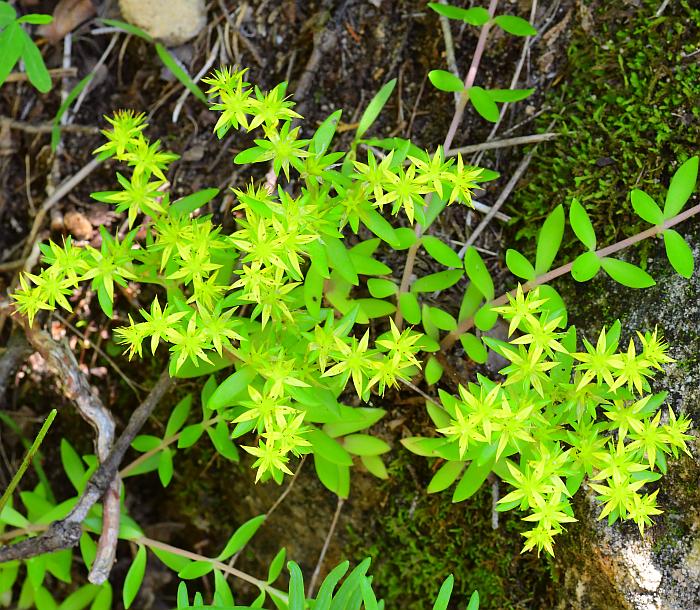Sedum sarmentosum Bunge
Yellow Stonecrop

Introduced
CC = *
CW = 5
MOC = 20
© SRTurner
Sedum sarmentosum BungeYellow Stonecrop | |
 |
Introduced CC = * CW = 5 MOC = 20 |
© SRTurner |
|
Family - Crassulaceae Habit - Perennial forb from fibrous roots, the stems rooting at the nodes. Stem - Prostrate, mat-forming, to 30 cm, light green to white, rarely reddish-or pinkish-tinged, not glaucous, the flowering branches 5-20 cm long, spreading to loosely ascending.
Leaves - Mostly in whorls of 3, less commonly opposite, sessile, attached just above the minutely pouched base, only slightly and gradually reduced in size toward the stem tip. Leaf blades 10-30 mm long, persistent at fruiting, thickened but somewhat flattened, narrowly depressed-oblong or somewhat rectangular in cross-section, narrowly oblanceolate to narrowly oblong-elliptic or nearly linear, sharply pointed at the tip, the margins entire, the surfaces green, not glaucous.
Inflorescences - Panicles with 2 or 3 branches, these loosely ascending, somewhat zigzag, few-flowered spikes.
Flowers - Sepals 5, 3.5-5.0 mm long, oblong-lanceolate, bluntly pointed at the tip, the base with a minute, pouchlike spur of tissue. Petals 5, 5-8 mm long, narrowly lanceolate, yellow. Stamens with the anthers yellow, often reddish-tinged, the filaments attached at the petal bases. Nectaries about as long as wide, oblong, yellowish orange to orange. Carpels 5, greenish yellow.
Fruits - Follicles, usually withering before full maturity, 4.5-6.0 mm long, spreading after flowering. Seeds aborting during development. Flowering - May - September. Habitat - Rocky streambanks, glades, ledges and tops of bluffs, cemeteries, roadsides, open to partially shaded disturbed areas, on both acidic and calcareous substrates. Origin - Native to Asia. Lookalikes - S. acre, S. nuttallianum Other info. - This plant is uncommon and widely scattered in Missouri, found in a handful of counties falling within the southern 2/3 of the state. It is likewise found in scattered locations in the eastern half of the U.S. The plant is recognized by its succulent leaves occurring in whorls of three, and bright yellow flowers with sharply pointed petals. It typically grows on rocky substrate, sometimes in crevices in rocky outcrops. It is also sometimes cultivated and therefore found around cemeteries and old homesites; however, since it rarely produces viable fruits, it usually does not escape over long distances. Photographs taken at Hodgson Mill, Ozark County, MO, 5-3-2012, and Onondaga Cave State Park, Crawford County, MO, 5-30-2022 (SRTurner). |